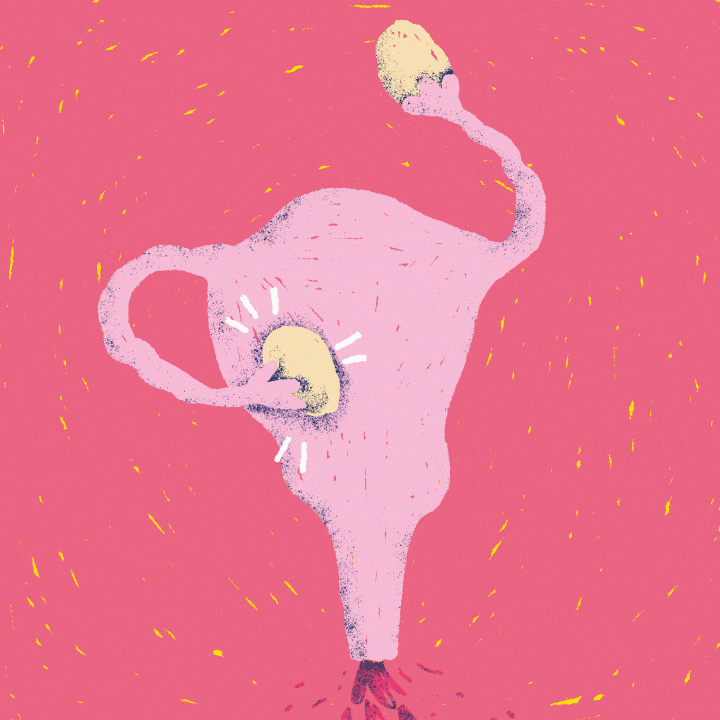
Published on Jun 20, 2023
Last modified on May 19, 2025
Period Out Of Whack During Perimenopause? What It Could Mean.
5 min read
Most women experience period changes as they move into perimenopause (the 8-10 year transition into menopause). Changes TRULY run the gamut, but common symptoms include:
- Irregular cycles
- Abnormally heavy or prolonged bleeding (menorrhagia)
- Increasingly painful cramps (dysmenorrhea)
And yes, abnormal bleeding can happen even if your cycle ran like clockwork before. 🤦♀️
Below, we’re breaking down different scenarios and what they may mean.
Long periods & cycles
By “long,” we mean bleeding that exceeds the usual duration of your menstrual periods (more than 7 days) as well as cycles that are longer than 38 days.
Heavy periods
By “heavy,” we mean soaking through one pad/tampon per hour for two or more hours, passing blood clots larger than a quarter, and/or waking up at night to change a pad or tampon.
It’s important to remember that a “heavy flow” is subjective, and what may be considered heavy for one person may not be the same for another. You need to know your own baseline, so that when things change you can understand it in that context — this is why your menstrual cycle is considered a fifth vital sign!
If you’re experiencing heavy periods, don’t worry if your healthcare provider recommends bloodwork, a transvaginal ultrasound, or even a uterine/endometrial biopsy after a physical exam. These are standard steps of a workup for heavy bleeding and are used to identify:
- Potential other hormonal issues (like with your thyroid)
- Anemia (aka iron deficiency due, in this case, to excess blood loss)
- Uterine abnormalities (e.g., fibroids, polyps)
- Precancerous changes in the uterine lining (called endometrial hyperplasia)
Missing periods
While decreased time between cycles (< 28 days) could be an early, first sign of perimenopause, increased time between periods often signals late perimenopause.
Spotting
Spotting is categorized as blood that appears between periods but doesn’t require the use of a pad or tampon. It usually occurs mid-cycle around during the ovulatory phase when our follicle-stimulating hormone, or FSH for short, is at its highest, stimulating egg growth in the ovaries. During this time, there’s also a buildup of the uterine lining, or endometrium.
When does the occasional spotting turn into talk-to-your-doctor spotting? If it happens regularly (every two weeks or so), it may be a sign of a broader hormonal imbalance.
IMPORTANT: Any and all vaginal bleeding is considered abnormal for postmenopausal women and should be a sign to talk to your doctor. (As a reminder, we’re considered postmenopausal once we’ve gone 12 consecutive months without a menstrual period…the average age is 51).
While the cause could very well be harmless (like vaginal dryness), it could also be a signal of a more serious medical condition, including uterine cancer or cervical cancer. If you have postmenopausal bleeding, call your gynecologist right away. And if you can, bring notes on the length, duration, and flow of your bleeding to that doctor’s appointment (more on tracking below).
The potential culprit(s) behind all this irregularity
Hormonal changes
Hormonal fluctuations are one of THE most common causes of irregular perimenopausal bleeding. Why? The two primary reproductive hormones for women, estrogen and progesterone, control menstruation along with a slew of other functions in our body.
- Estrogen: causes the endometrium, or the lining of the uterus, to thicken during a typical menstrual cycle
- Progesterone: balances estrogen by controlling the build-up of the endometrium and preparing the lining for the potential of pregnancy
When hormone levels shift and eventually decline during the menopausal transition, the result is irregular periods. Typically, as early perimenopause shifts into late perimenopause and the last menstruation approaches, cycles become more irregular, and scarce due to declining estrogen levels, often absent ovulation, and less growth of the uterine lining.
Uterine fibroids
Fibroids (aka leiomyomas or myomas) are gynecologic tumors — which sounds scary, we know. But they’re mostly always benign, or noncancerous. Only in rare cases do new fibroids begin as cancer, but they can’t turn into cancer. Symptoms of fibroids include frequent urination, abdominal bloating, lower back or abdominal pain, painful sex, and, yes, heavy bleeding.
Risk factors for fibroids include race/ethnicity, obesity, family history, high blood pressure, and vitamin D deficiency.
READ MORE: What’s The Deal With Fibroids & Menopause
Other health conditions
Period irregularities during perimenopause could very well be due to other causes as well, including thyroid and prolactin abnormalities, polycystic ovary syndrome (PCOS), adrenal problems, coagulation (blood clotting), extreme stress, illness, etc.
Periods that suddenly become irregular may require a workup to exclude causes other than perimenopause, especially for women in their early 40s.
Pregnancy (yes, really!)
While a skipped period at 40 may mean perimenopause (or any of the culprits listed above), it can also mean pregnancy! Remember, we’re still technically in our reproductive years during this time.
Expert tips, recommendations & treatment options
Track, track, track!
Before your next annual visit, track your cycle for 1-2 months to share with your doctor. Tracking specific cycle length between periods, duration of your period, and flow can help your doctor better understand where you are in the perimenopause transition, or whether there is potentially something else that should be evaluated.
Give absorbent period underwear a whirl
Concerned about leaking? Try products such as Knix and Thinx, which can absorb up to four tampons worth of flow — and feel free to still use pads or tampons for a double layer of menstruation protection.
Explore supplements — but know that there’s little hard science behind them
- Vitex (aka chastetree, monk’s pepper, or Abraham’s balm): peppercorn-sized fruit frequently used as an herbal remedy for those experiencing frequent menstruation. It works by increasing progesterone to help regulate cycles.
- Ginger: taken in oil/juice form as an anti-inflammatory to tame heavy periods and bad cramps
READ MORE: Elektra Guide To Supplements For Menopause
Consider hormonal treatments
1. Low-dose oral contraceptives
Birth control pills that contain a lower dose of estrogen and progestin, which is a synthetic form of progesterone. Also a good option for women who still require contraception in perimenopause.
Phase: Early-late perimenopause
2. Sequential progesterone
A cyclical solution where progesterone is given in the form of progestin pills every day for a set number of days. This is repeated monthly in order to cause regular, light menstrual cycles.
Phase: Early-late perimenopause
3. Hormonal intrauterine device (IUD)
Hormonal IUDs slowly release progestin into the uterus, which thins the uterine lining, which leads to less bleeding. Some women may stop having periods altogether. IUDs can be kept in for 5+ years, and need to be inserted and removed by a provider.
Phase: Early-late perimenopause
4. Hormonal implants or injections
There are a number of available hormonal implants and injections that are available. The use of these are very personalized, and would be specific to your situation.
Phase: Early-late perimenopause
READ MORE: Elektra’s Guide To Hormone Replacement Therapy (HRT)



